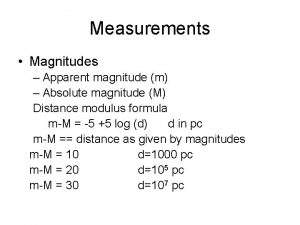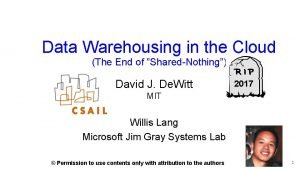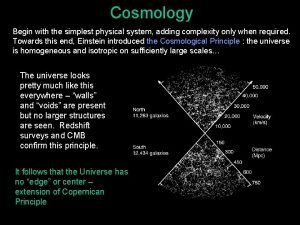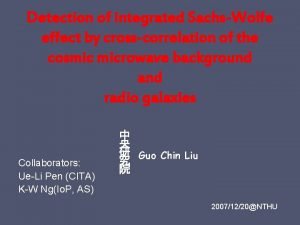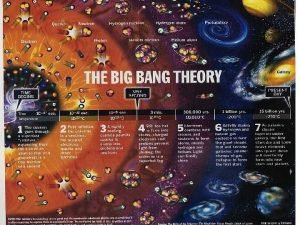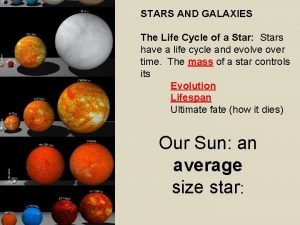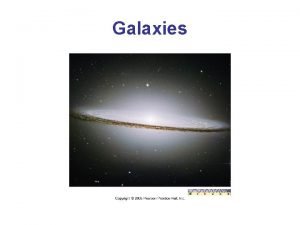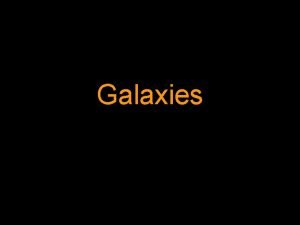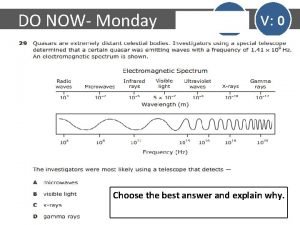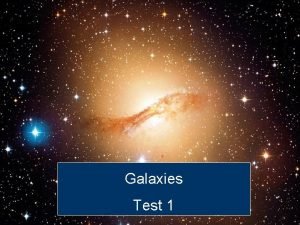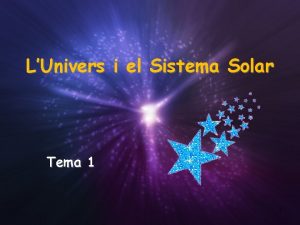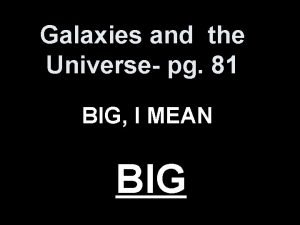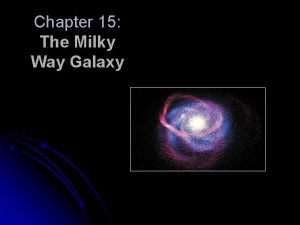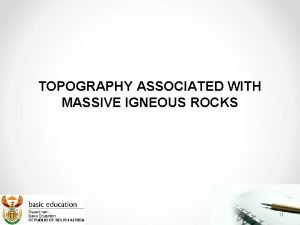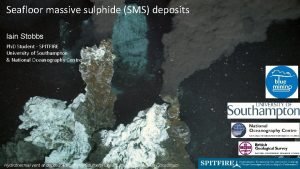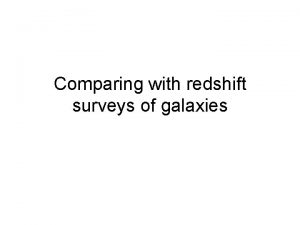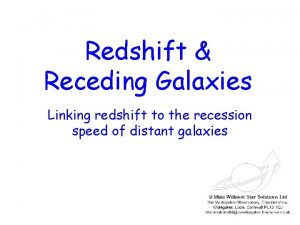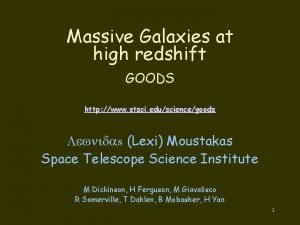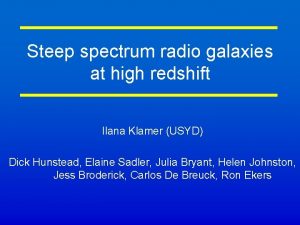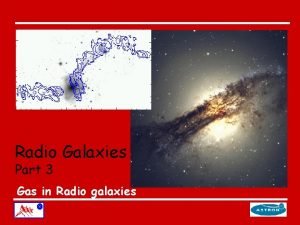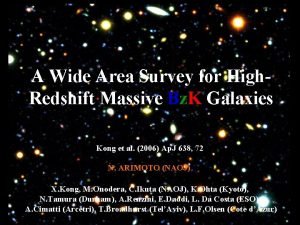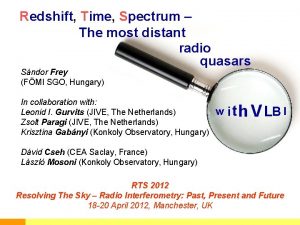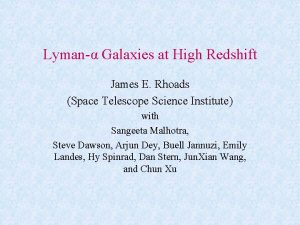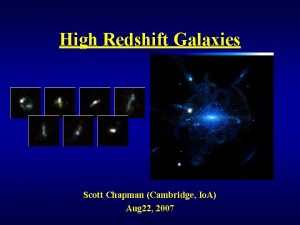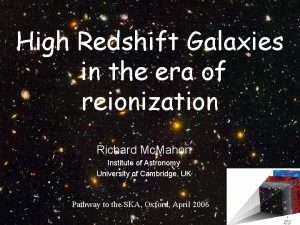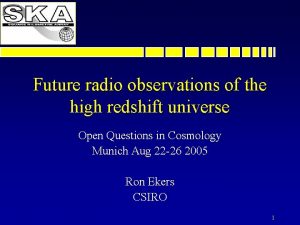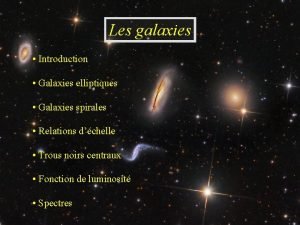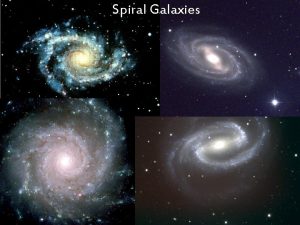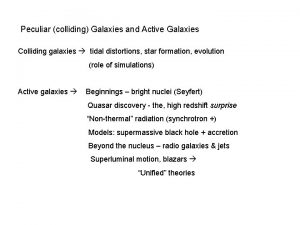High Redshift Radio Galaxies The most massive galaxies




























- Slides: 28

High Redshift Radio Galaxies: The most massive galaxies up to z>5? Carlos De Breuck (ESO) cdebreuc@eso. org n n n How massive are High-z Radio Galaxies (Hz. RGs)? Does their AGN bother or help us? The overdense environments of Hz. RGs. What is their space density? What is their relation with submm galaxies?

Are Hz. RGs Massive? Host galaxies are ellipticals. Surface Brightness n n R 1/4 Zirm et al 2003, Pentericci et al 2002 At z<1, powerful radio sources are associated with g. E and c. D galaxies. At z<2. 5, HST/NICMOS host galaxy imaging show de Vaucouleurs profiles. F 622 W F 160 W

Are Hz. RGs Massive? Dynamical mass determinations. ΔV(km/s) n n 3 C 265 (z=0. 8) mass measured from [OII] rotation curve: 8 x 1010 MSun within 15 kpc. CO measurements in four z>3 RGs yield dynamical masses of order 5 x 1011 MSun within 20 kpc. offset Dey & Spinrad 1996, Papadopoulos et al 2000

Are Hz. RGs Massive? The K-z relation out to z=5. 2 Total K magnitude n n Hz. RGs are most luminous galaxies in K-band. Follow iso-mass lines for Mbar =1012 MSun. Caveats: n n Redshift n Radio power dependence. Direct and/or scattered AGN contributions? k-correction effects. De Breuck et al 2001, Rocca-Volmerange et al 2004

K-z diagrams of submm and X-ray selected galaxies submm selected sources Total K magnitude X-ray selected sources Stern et al 2002 Serjeant et al 2003

Radio power dependence in the K-z diagram. n 3 C, 6 C and 7 C samples show mean offsets of >0. 5 in K. More powerful radio sources contain more massive black holes → more massive host galaxies? n Provides natural explanation why Hz. RG are so massive. Eales et al 1996, Willott et al 2003 n

Does their AGN bother us? n Radio-loud AGN type II → natural coronograph. Contributions to observed K-band: n Old stellar population → what we want to know. n Young stellar population → estimate ages using photometry across 4000Å break. n AGN emission lines → select line-free bands or do near-IR spectroscopy. n Scattered AGN continuum → spectropolarimetry. n Transmitted AGN continuum → mid-IR imaging with Spitzer and/or H spectroscopy.

The rest-frame K-z diagram. Spitzer program on 70 Hz. RGs: n 1<z<5. 2 n Range of radio luminosity. n 4 IRAC bands, IRS 16 µm (z>2), 3 MIPS bands. n Sample with large amount of existing data. Goals: n Imaging at peak of old stellar population → Mass n UV to radio SED. Stern, De Breuck, Seymour, Lacy, Zirm, Rocca-Volmerange, Rettura, Vernet, Fosbury, Stanford, van Breugel, Miley, Dickinson, Dey, Mc. Carthy, Eisenhardt, Teplitz.

Ly halos around Hz. RGs. 150 kpc PKS 1138 -262 (z=2. 16) Kurk et al. 2003 200 kpc 4 C 41. 17 (z=3. 80) Reuland et al. 2003

Emission-line halos around Hz. RGs. n Narrow-band Ly imaging of Hz. RGs often shows very extended halos (e. g. van Ojik et al 1996, Venemans et al 2002, Reuland et al 2003). z Size [kpc x kpc] Log Ly [erg/s] PKS 1138 -262 2. 16 150 x 120 44. 3 B 2 0902+34 3. 40 140 x 100 44. 8 4 C 1243+036 3. 57 160 x 50 44. 0 4 C 60. 07 3. 79 110 x 60 45. 1 4 C 41. 17 3. 80 190 x 130 45. 2 TN J 1338 -1942 4. 10 150 x 40 44. 7 Name

Chemically enriched emission line halos. 80 kpc Deep Keck spectroscopy shows NV 1240, CIV 1540, He. II 1640 emission extending beyond the radio lobes (Maxfield et al 2002, Villar-Martin et al 2003). 4 C+23. 56 z=2. 48

Proto-clusters around Hz. RGs. n RG with 2. 1<z<5. 2 have an overdensity of Ly emitters (e. g. Venemans et al 2002, 2004). Name z PKS 1138 -262 2. 16 70 14 ~1000 MRC 0052 -241 2. 86 73 37 ~900 MRC 0943 -242 2. 92 ~70 29 ~800 MRC 0316 -257 3. 13 92 31 ~625 TN J 2009 -3040 3. 15 20 11 ~470 TN J 1338 -1942 4. 10 50 32 ~350 TN J 0924 -2201 5. 19 ~20 6 N/A # candidates #confirmed Δv

Example: n TN J 1338 -1942 (z=4. 1) contains: 1. 30 Ly emitters (Venemans et al 2002) 2. 56 g-band dropouts (HST/ACS; Miley et al 2004). 3. 6 (sub)mm galaxies (De Breuck et al 2004).

Proto-clusters around Hz. RGs. n n Factor 3 -5 overdensity compared to blank fields. Velocity dispersion <half of filter bandwidth. If just detached from Hubble flow, M~5 x 1014 MSun. Ly emitters have SFR=1 -10 MSun/yr, mm sources have SFR ~ 2000 MSun/yr. Consistent with Hz. RGs as massive galaxies tracing the densest regions out to z>5.

Space density of Hz. RGs. Space density reasonably well known out to z~3. Very uncertain beyond z=3 because only ~30 z>3 radio galaxies are known to date. n n 0 1 2 3 4 5 6 7 Redshift Jarvis et al 2001, Willott et al 2001 2 3 4 Redshift

Filtered Hz. RG surveys. n Radio Spectral Index n Unfiltered radio surveys (3 C, 6 C, 7 C, MRC, …) have <z>~1. Most succesful high-z selection is based on Ultra Steep Radio spectra (USS), <z>~2. 5. n n n 0 1 2 3 4 Redshift 5 6 Uses concave shape of radio spectrum. k-correction shifts steeper part to observed wavelengths. >90% of z>3 galaxies discovered via USS. De Breuck etal 2000 -2004

TN J 0924 -2201 at z=5. 2 n K-band + radio Flux Fλ n Extreme USS source with K=21. 3 host galaxy. Surrounded by 6 confirmed Ly emitters. Wavelength Venemans et al 2004 van Breugel etal 1999

USS sources without redshifts. Flux Fν n n Wavelength ~30% of USS sources fail to yield a redshift after 1 h+ of Keck/VLT spectroscopy. Either no emission at all or featureless continuum. Very obscured galaxies or at z>7? Compact (→ young? ) radio morphologies. De Breuck et al 2001

Example: WN J 0305+3525. n n Bright (sub)mm source. Not detected in 12. 6 ks with Chandra → heavily obscured source with n. H~few 1023 cm-2. Radio-optical SED consistent with z~3. K-band + radio + SCUBA 850µm ν Fν n Reuland et al 2003 Log observed frequency

Sub-mm observations of Hz. RGs. Number S 850 rises with z Detection fraction z<2. 5 ~15 % Detection fraction z>2. 5 ~50 % Redshift Archibald et al 2001, Reuland et al 2004

Dominated by young stars Hz. RGs contain strong AGN that could heat the dust. n No correlation between radio power and S 850. n Anti-correlation between S 850 and UV polarization. n All submm-loud Hz. RGs also show CO emission tracing the gas reservoir feeding starbursts. → Hz. RGs may be radio-loud counterparts of SMGs? n Dominated by scattered quasar S 850 Sub-mm emission: AGN or starburst? UV polarization

Star Formation History of Hz. RGs. n n <L 850> n LFIR ~ 1013 LSun. SFR ~ 1500 MSun/yr. SFR increases with redhsift at least until z~4. → More luminous than ULIRGs. → Forming the bulk of their stellar populations. 0 2 4 Redshift 6 What is the role of mergers?

CO emission in Hz. RGs n n CO traces H 2 → M(H 2) ~ 1 to 5 x 1010 MSun. CO velocity widths up to 1000 km/s → Mdyn » 1011 MSun CO redshift often offset from AGN redshift → real systemic redshift of AGN host galaxy. In at least 2/5 cases CO is distributed in 2 components. Name B 3 J 2330+3927 SCO ΔV ΔVCO [km/s] [Jy km/s] 3. 09 1. 3± 0. 3 500 z TN J 0121+1320 3. 52 700 1. 2± 0. 4 6 C 1909+72 3. 54 530 1. 6± 0. 3 4 C 60. 07 3. 79 >1000 2. 5± 0. 4 4 C 41. 17 3. 80 900 2. 1± 0. 2

CO emission in 4 C 41. 17 n n CO is in 2 components with M(H 2)≈3 x 1010 MSun. Each component coincident with a dark lane in Ly De Breuck et al, in prep.

Mergers seen in CO? n n In 4 C 60. 07 and 4 C 41. 17, the CO(4 -3) is in two components, separated by ~500 km/s and ~15 kpc. Suggest merger of two gas-rich galaxies cfr. local ULIRGs. But no galaxies seen in optical/near-IR imaging → high obscuration? De Breuck et al, in prep. Offset n Velocity

Conclusions n n n The Hubble K-z diagram shows that Hz. RGs are amongst the most massive galaxies known to z>5. At z<2. 5, their host galaxies are ellipticals. Many (most? ) Hz. RGs are in giant Ly haloes and proto-clusters. Space density is ill constrained at z>3, where they are only found in USS samples. At z>3, RGs are strong submm sources powered by starbursts. Their enormous LFIR suggests they are forming the bulk of their stellar population. CO emission in z>3 RGs is often in 2 components, suggesting gas-rich mergers.

Future Work n n n Rest-frame K-z diagram using Spitzer → mass. Larger samples of z>3 RG to constrain their space density (e. g. Texas Oxford One Thousand). Very wide-field (1000+ sq. degrees) near-IR surveys to determine Hz. RG space density. Expand coverage around existing Hz. RG protoclusters to determine their full size (» 2 Mpc). Deep CO observations with wide frequency coverage to study where most of the mass is located → possible with e. VLA and ALMA.

Coming in 2007!
 Redshift formula
Redshift formula Redshift shared nothing
Redshift shared nothing The universe expanding than
The universe expanding than Redshift deadlock detected
Redshift deadlock detected Big bang solar system
Big bang solar system Aws queue icon
Aws queue icon Redshift create index
Redshift create index Most galaxies in the inner region of a large cluster are
Most galaxies in the inner region of a large cluster are Trunking vs conventional radio system
Trunking vs conventional radio system Waves produced by stars and galaxies
Waves produced by stars and galaxies Life cycle of a galaxy
Life cycle of a galaxy Elliptical galaxies facts
Elliptical galaxies facts E irregulars
E irregulars The pity relation for an adiabatic expansion is
The pity relation for an adiabatic expansion is Chapter 30 galaxies and the universe
Chapter 30 galaxies and the universe Types of galaxies
Types of galaxies Brainpop galaxies quiz answers
Brainpop galaxies quiz answers 4 types of galaxies
4 types of galaxies How are galaxies classified? *
How are galaxies classified? * Galaxie s
Galaxie s Tipus de galaxies
Tipus de galaxies Type of galaxy
Type of galaxy Evolution of galaxies
Evolution of galaxies Universepg
Universepg Galaxies lesson plan
Galaxies lesson plan There once was a woman from china who had a massive
There once was a woman from china who had a massive Igneous rock
Igneous rock Seabed massive sulphides (sms)
Seabed massive sulphides (sms) Massive transformative purpose
Massive transformative purpose
